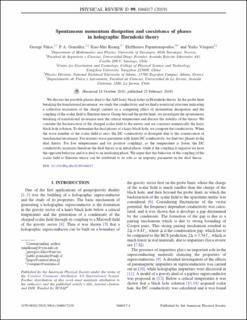| dc.contributor.author | Filios, Georgios | |
| dc.contributor.author | Gonzalez, P. A. | |
| dc.contributor.author | Kuang, Xiao-Mei | |
| dc.contributor.author | Papantonopoulos, Eleftherios | |
| dc.contributor.author | Vasquez, Yerko | |
| dc.date.accessioned | 2023-01-25T14:49:40Z | |
| dc.date.available | 2023-01-25T14:49:40Z | |
| dc.date.created | 2019-08-15T14:24:05Z | |
| dc.date.issued | 2019 | |
| dc.identifier.citation | Filios, G., González, P. A., Kuang, X. M., Papantonopoulos, E., & Vásquez, Y. (2019). Spontaneous momentum dissipation and coexistence of phases in holographic Horndeski theory. Physical Review D, 99(4), 046017. | en_US |
| dc.identifier.issn | 2470-0010 | |
| dc.identifier.uri | https://hdl.handle.net/11250/3046395 | |
| dc.description.abstract | We discuss the possible phases dual to the AdS hairy black holes in Horndeski theory. In the probe limit breaking the translational invariance, we study the conductivity and we find a nontrivial structure indicating a collective excitation of the charge carriers as a competing effect of momentum dissipation and the coupling of the scalar field to Einstein tensor. Going beyond the probe limit, we investigate the spontaneous breaking of translational invariance near the critical temperature and discuss the stability of the theory. We consider the backreaction of the charged scalar field to the metric and we construct numerically the hairy black hole solution. To determine the dual phases of a hairy black hole, we compute the conductivity. When the wave number of the scalar field is zero, the DC conductivity is divergent due to the conservation of translational invariance. For nonzero wave parameter with finite DC conductivity, we find two phases in the dual theory. For low temperatures and for positive couplings, as the temperature is lower, the DC conductivity increases therefore the dual theory is in metal phase, while if the coupling is negative we have the opposite behavior and it is dual to an insulating phase. We argue that this behavior of the coupling of the scalar field to Einstein tensor can be attributed to its role as an impurity parameter in the dual theory. | en_US |
| dc.language.iso | eng | en_US |
| dc.publisher | American Physical Society | en_US |
| dc.rights | Navngivelse 4.0 Internasjonal | * |
| dc.rights.uri | http://creativecommons.org/licenses/by/4.0/deed.no | * |
| dc.title | Spontaneous momentum dissipation and coexistence of phases in holographic Horndeski theory | en_US |
| dc.type | Peer reviewed | en_US |
| dc.type | Journal article | en_US |
| dc.description.version | publishedVersion | en_US |
| dc.rights.holder | The authors | en_US |
| dc.subject.nsi | VDP::Matematikk og Naturvitenskap: 400 | en_US |
| dc.source.pagenumber | 19 | en_US |
| dc.source.volume | 99 | en_US |
| dc.source.journal | Physical Review D | en_US |
| dc.identifier.doi | 10.1103/PhysRevD.99.046017 | |
| dc.identifier.cristin | 1716187 | |
| cristin.ispublished | true | |
| cristin.fulltext | original | |
| cristin.qualitycode | 1 | |

